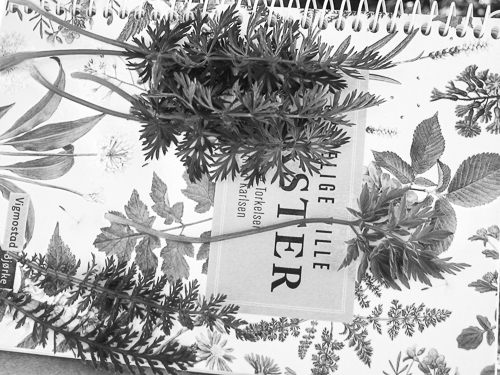Herbs have been used for food, medicine and for religious purposes for ages. Nowadays, people in rich countries can buy all sorts of edible plants, like fruits, vegetables and herbs all year. Until a few years ago, many of them were only available in summer and the range was rather limited, but then something happened which both extended availability to all year and a much wider range. Anyway, I feel a need to trust nature and not just buy plants cultivated by man, but plants growing wild in nature, never having been modified in any way by man because they have been and remain marginal.
Thus, I recently joined a course on culinary herbs arranged by the mushroom and culinary herbs association in Oslo at NaKuHel in Asker. The first two times, after having introduced ourselves and got a booklet on culinary herbs, we were shown a variety of herbs, all which were growing locally. Since our instructors had already collected them, we could use touch, sight, smell and taste to get to know them. We also learnt about their habitats, what part of the herbs we could eat, when we could them and herbs which looked almost the same. Besides, we were taught about poisonous herbs.
The third time we should go for a short walk, collecting culinary herbs. Since NaKuHel is located near a lake called Semsvannet, which is protected as a conservation area. It’s a beautiful area, consisting of meadows, deciduous forests, ponds, wetlands and cultural landscapes. The instructors and the more experienced course participants had brought plastic bags, scissors, tools to dig up roots, baskets and gloves. Obviously, there is always something to learn! Actually, the booklet we got the first time recommends using one plastic bag for each type of plant. By keeping humidity inside the bag, it also aids in preventing the plants from withering. When we came to a meadow, the tools for digging up roots came in handy because there were lots of caraway, whose roots we should use for making soup, on the meadow. I also tasted fresh rowan leaves for the first time and they tasted like almonds. What a pleasant surprise! On our way next to the lake, we found an elm tree with lots of fruits called samaras, some of which we picked. In wet places near the lake, we could find large bitter-cress, while Good King-Henry was growing on the roadsides.
The fourth time, we should prepare salad, soup, omelette, vegetable balls and biscuits based on the herbs we had collected together with ingredients like eggs, flour, butter, vegetable oil, etc. The recipes are given in Norwegian here. The following list should hopefully show all the herbs, which were collected:
⦁ Good-King-Henry
⦁ Caraway
⦁ Rowan, only the smallest leaves
⦁ Elm, only the fruits, which are called samaras
⦁ False baby’s breath
⦁ Common nettle
⦁ Cicely
⦁ Ramson
⦁ Ground elder
⦁ Dandelion
⦁ Vetch
⦁ Large bitter-cress
⦁ Rosebay willowherb
The participants selected partners and which dish they would prepare, while I just picked samaras from branches of elm. Quite a few times small caterpillars and also some other critters emerged. Since there was a flower bed just outside the kitchen, it was easy to dispose of them there. Next, when all the dishes were prepared, we sat down to eat a group of delicious dishes together, a really nice way to finish the course.
Now and till the end of June, we can eat a large variety of culinary herbs, while they will gradually have a more coarse consistency and a bitter taste. Anyway, what I really like about them is that they are apparently growing and thriving whether it’s hot or cold, wet or dry contrary to domestic food plants, which require artificial irrigation, weeding, artificial fertilisers, etc.
Wild, edible herbs can also be found in Indonesia as described here.

